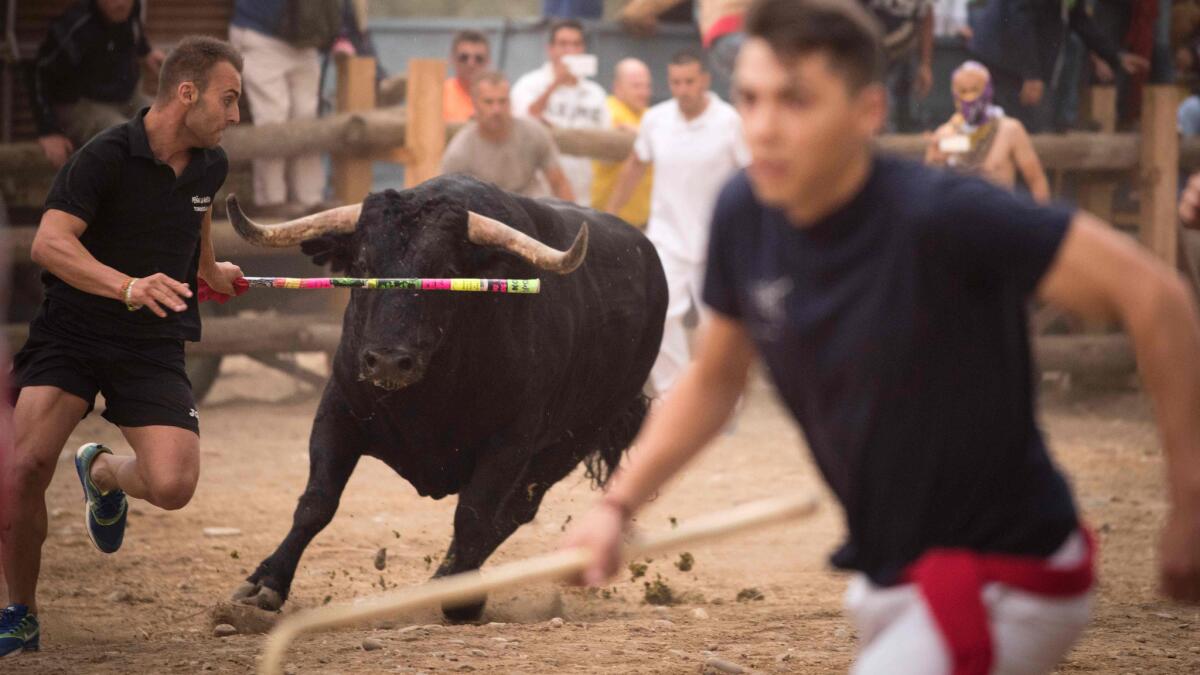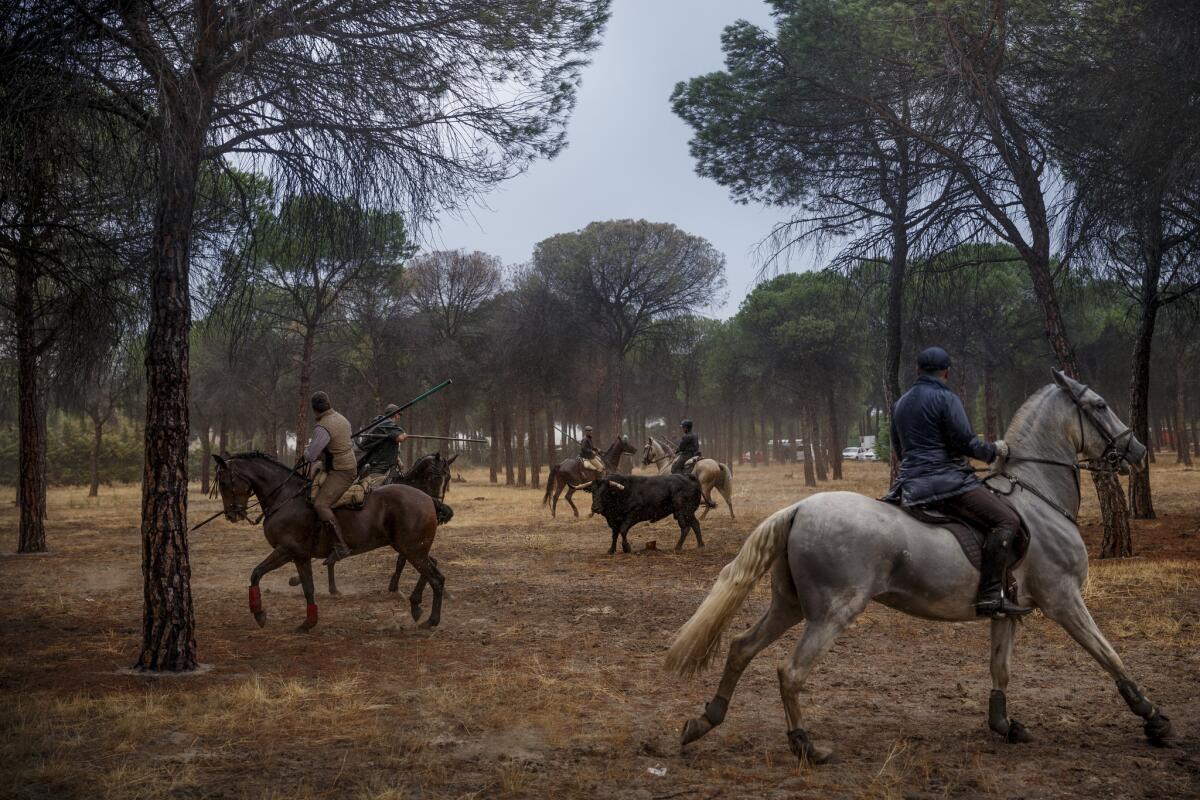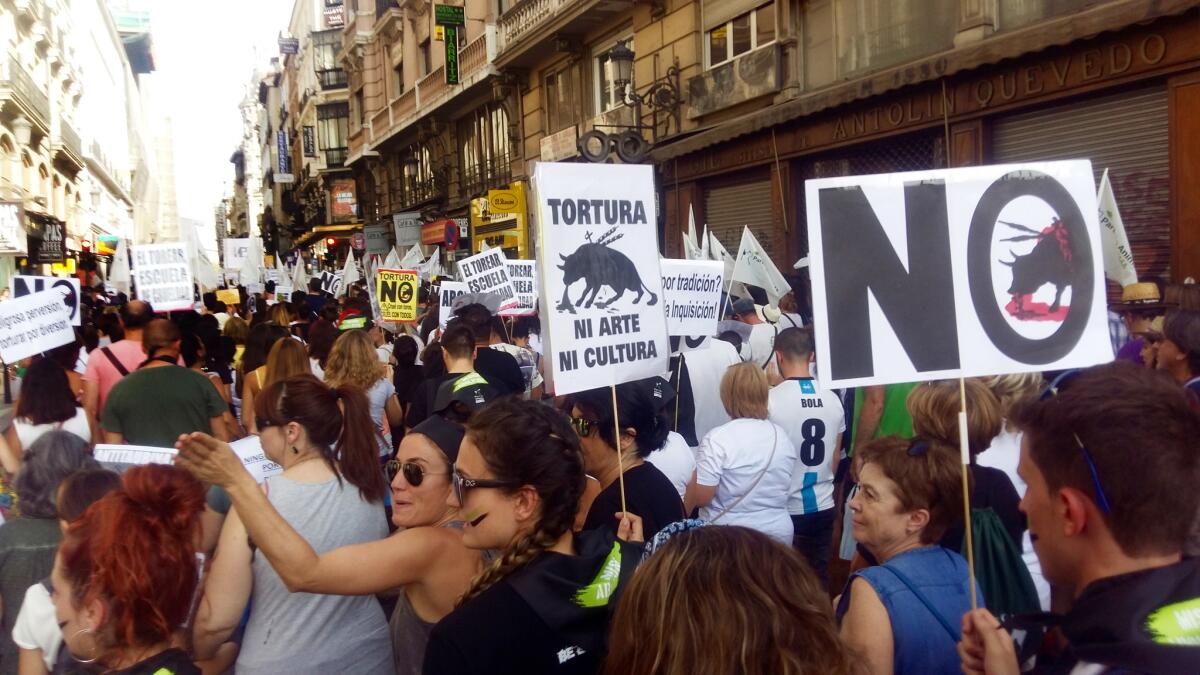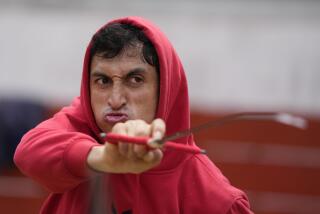In Spain’s Tordesillas, Pelado the bull encounters both anger and pleasure tied to his fate

- Share via
Reporting from Tordesillas, Spain — With a salvo of rockets fired from a bridge over the River Duero, a metal gate swings wide, and a 1,200-pound bull bolts out through the smoke.
He careens through this cobblestone warren on Spain’s central meseta plateau, pursued by thousands of flag-draped revelers. “Olé!” they scream and scramble after him.
The animal, foaming at the mouth, flees into a dusty field dotted with junipers, only to face a phalanx of horsemen armed with spears, ready to kill him.
This spectacle has played out in the town of Tordesillas, about 115 miles northwest of Madrid, the capital, at a festival on the second Tuesday of September nearly every year since medieval times. Tradition calls for the bull to be stabbed to death as he staggers around the field alternately trying to charge at, and escape from, his bemused predators.
But this year, the law called for the bull to survive — and the people of Tordesillas, lots of them, were furious.
“It’s not that we’re against animals,” said retiree Trinidad Vazquez, 60. “It’s that we’re in favor of our local traditions, our history, our way of life.”
The regional government of Castile and León in May outlawed the final bloody act — the killing of the bull — at what has been known as Toro de la Vega, one of Spain’s most emblematic and controversial festivals. Everything else was to stay the same — the rockets, the run, the wild chase.
The government’s decision, which applies only to this one local festival officially renamed Toro de la Peña, after the town’s patron saint, Virgen de la Peña, came after years of protests and lobbying by animal rights groups.

Bulls are still killed at hundreds of other small-town festivals across Spain, but this one gained notoriety as being particularly cruel and thus became an early flashpoint for the animal rights debate. Even Spanish dictator Gen. Francisco Franco prohibited Tordesillas from holding its annual festival for four years in the 1960s, after negative publicity abroad.
Bullfighting — in which bulls also are stabbed and bled slowly, then killed — is still legal in all but two of Spain’s 17 regions (Catalonia and the Canary Islands). It’s widely practiced, though turnout at bull rings nationwide has dwindled since the 2008 economic crisis.
Over the past year, as the left-wing party Podemos has gained seats in municipal and regional legislatures, at least 17 Spanish cities have cut funding for bullfights, or banned them locally.
Several other countries that practice bullfighting also are seeing changes. In Mexico, for example, three states have banned bullfighting in recent years, and a fourth is considering it.
Some animal rights activists said they see the change at Toro de la Vega, as many people still call it, as a small but significant step toward banning blood sport in Spain altogether.
In some ways, they said, it reflects a change in Spanish public opinion, a generation after Spaniards embraced democracy, migrated to cities for work, joined the European Union and began to cast off traditions associated with their poor, rural past. An Ipsos Mori poll this year found that 19% of adults in Spain support bullfighting, with 58% opposed. It’s a rural-urban divide, and generational too.
“Growing up in a small town, I felt like Spain was two countries living in the same moment. It’s like I live in the 21st century, and you still live in the 15th century. But we are changing really, really fast,” said Silvia Barquero, president of PACMA, a Spanish animal rights political party established in 2003.
During the summer, the political party sent activists undercover to film another festival in Toledo, south of Madrid, where a baby bull was tortured and stabbed to death by drunken revelers. The video, posted online, is graphic and disturbing. You can hear children cheering “Olé!” off-camera, as the disoriented animal vomits blood, before dying. The footage went viral, with 20 million views on social media in the first 24 hours, Barquero said.
The party encouraged anyone angry about what they saw in the Toledo video to attend an anti-bullfighting march Sept. 10 in Madrid. Several thousand turned out. It was the largest such demonstration in years.

“Torture is not culture!” protesters chanted. Some homemade signs read “Bullfighting, school of cruelty” while others showed illustrations of a wounded bull.
But not everyone has agreed with the animal rights activists. In 2013, Spain’s conservative government passed a measure declaring bullfighting part of Spain’s “cultural heritage worthy of protection.” It allows public funds to be used to promote and protect bullfighting and other bull-related festivals, like the Running of the Bulls each July at the San Fermin festival in Pamplona.
Many lawmakers vowed to overturn the measure, but a political deadlock has prevented any action.
Acting Prime Minister Mariano Rajoy calls himself an aficionado of bullfighting.
About an hour before this year’s festival in Tordesillas — the first since the bull-killing ban took effect — Vazquez, the retiree, joined thousands marching along the bull’s roughly half-mile route, carrying a banner that read: “Tordesillas will not surrender.”
“They’ve unfairly singled us out, and distorted our festival. We deserve some respect,” she said, shaking her fist.
Behind them, a loudspeaker affixed to the town hall piped out a romantic ballad about killing “brave bulls.” People shooed away reporters. Many said they’re disgusted with politicians, the animal rights movement, the media — and political correctness altogether.
As the festival drew to a close, the moment arrived when the bull normally would have been stabbed to death. Some festival-goers brandished lances, vowing to kill the animal anyway, risking arrest.
Mounted police moved in. So did dozens of animal rights protesters, who had carpooled from Madrid, to ensure the killing ban was enforced. Outnumbered by thousands of festival-goers, they hid behind police lines, trading barbs with the men with spears.
“Cowards!” each group yelled at the other.
But just then, the sky opened up — drowning out all the rival insults, and dousing everyone with the first rain in several months. The dusty field turned into a big mud puddle. Loyalists from both sides ran for cover and found themselves shivering, shoulder-to-shoulder in silence, under the same tent awnings.
At that moment, handlers escorted the bull — a husky black 5-year-old named Pelado — to a nearby corral without any interference. He was the first animal in centuries to survive this spectacle.
Frayer is a special correspondent.
ALSO
Dare to be dull. Vibrant Berlin seems ready to reelect its plodding mayor
‘A massacre is inevitable’: Punishing siege drags on for two Shiite villages in Syria
A Cervantes tour of Spain: Real places from the fictional world of ‘Don Quixote’
More to Read
Sign up for Essential California
The most important California stories and recommendations in your inbox every morning.
You may occasionally receive promotional content from the Los Angeles Times.










